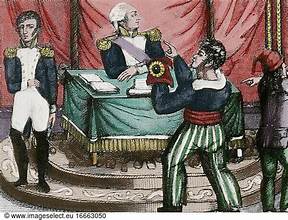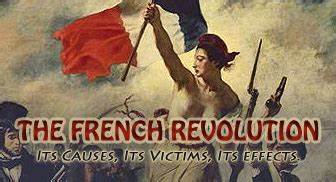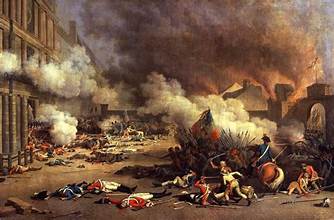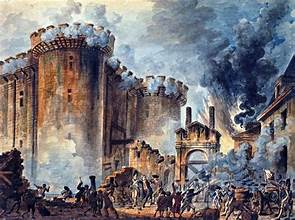The French Revolution (1789–1799): A Deep Dive into the Fall of the Old Regime
Introduction
The French Revolution, spanning from 1789 to 1799, was one of the most transformative events in world history. It marked the end of centuries of monarchical rule, the birth of modern democracy, and introduced radical social and political changes. The Revolution didn’t merely affect France—it inspired movements across Europe and the world. It was a complex, multi-stage uprising involving economic hardship, political oppression, Enlightenment ideals, and the relentless quest for liberty, equality, and fraternity.
I. Background and Causes of the Revolution
1. Social Structure: The Estates System
France was divided into three rigid estates:
- First Estate: The clergy (less than 1% of the population, yet held vast land and wealth).
- Second Estate: The nobility (about 2% of the population, with privileges, tax exemptions, and control of high offices).
- Third Estate: Everyone else—from the bourgeoisie (middle class) to peasants (97% of the population, heavily taxed and with no political power).
This structure bred immense social inequality.
2. Economic Crisis
France was in deep financial trouble by the late 18th century. Key reasons:
- Involvement in expensive wars, especially the American Revolution.
- Lavish spending by the monarchy, particularly Louis XVI and Marie Antoinette.
- A tax system that burdened only the poor, while the rich paid little or nothing.
- Bad harvests in the 1780s, leading to food shortages and skyrocketing bread prices.

3. Enlightenment Ideals
Philosophers like Voltaire, Rousseau, and Montesquieu questioned absolute monarchy and promoted ideas like liberty, social contract, popular sovereignty, and separation of powers. Their writings inspired people to challenge the status quo.
II. The Road to Revolution (1787–1789)
1. Financial Breakdown and the Estates-General
Faced with bankruptcy, Louis XVI called the Estates-General in May 1789, a general assembly of all three estates—the first time since 1614. However, voting was unfair: each estate had one vote, allowing the First and Second to outvote the Third.
Frustrated, the Third Estate broke away and declared themselves the National Assembly, vowing to create a new constitution in the famous Tennis Court Oath on June 20, 1789.
2. Storming of the Bastille (July 14, 1789)
The storming of the Bastille, a symbol of royal tyranny and political imprisonment, marked the Revolution’s explosive beginning. Armed citizens seized the fortress, and the day became France’s national holiday.

III. Major Phases of the French Revolution
1. The National Assembly (1789–1791)
- Abolition of Feudalism: On August 4, 1789, feudal privileges were abolished.
- Declaration of the Rights of Man and of the Citizen: On August 26, 1789, the Assembly issued a charter of freedom, liberty, and equality, heavily inspired by Enlightenment ideals.
- Civil Constitution of the Clergy (1790): Subordinated the Catholic Church to the state, causing a rift with religious groups.
- Constitution of 1791: Established a constitutional monarchy with the king as a symbolic leader and the Legislative Assembly holding power.
2. The Monarchy Falls (1792)
- Flight to Varennes (June 1791): Louis XVI tried to flee France but was captured. This undermined trust in the monarchy.
- War with Austria and Prussia: Foreign monarchies feared revolutionary ideas spreading, so they attacked France in 1792. The war radicalized the Revolution.
- Storming of the Tuileries (August 1792): The royal palace was attacked, and Louis XVI was arrested.
3. The Radical Republic and Reign of Terror (1792–1794)
- National Convention declared France a Republic on September 21, 1792.
- Execution of Louis XVI: On January 21, 1793, the king was guillotined for treason.
- Rise of Robespierre and the Jacobins: They led the Committee of Public Safety to purge enemies of the Revolution.
- Reign of Terror: From 1793 to 1794, thousands were executed, including Queen Marie Antoinette, political opponents, and innocent civilians.
- Cult of the Supreme Being: Robespierre tried to replace Christianity with a deistic state religion.
- Fall of Robespierre: On July 27, 1794 (9 Thermidor), he was arrested and executed, ending the Terror.
4. The Directory (1795–1799)
- New Constitution (Year III): Replaced the National Convention with a five-member Directory and a bicameral legislature.
- The period was marked by:
- Corruption and inefficiency.
- Economic instability and hunger.
- Revolts and continuous war with foreign coalitions.
Amid chaos, one military general rose to prominence: Napoleon Bonaparte.
IV. Rise of Napoleon and the End of the Revolution (1799)
On November 9, 1799 (18 Brumaire), Napoleon staged a coup d’état, overthrowing the Directory and establishing the Consulate, effectively ending the French Revolution.
Napoleon later declared himself Emperor, but many revolutionary reforms—like equality before the law and secular governance—remained under his rule.

V. Key Themes and Impacts
1. Social Change
- Abolished feudal privileges: No more titles of nobility, special taxes, or inherited status.
- Opened up education, military, and government positions to talent rather than birth.
2. Political Evolution
- Transitioned France from absolute monarchy to republicanism, then to military dictatorship.
- Birthed new political ideologies: liberalism, radicalism, conservatism, and nationalism.
3. Legal and Civic Legacy
- The Revolution laid the groundwork for modern constitutions.
- Influenced the Declaration of Human Rights, civil liberties, and secular governance.
4. Global Influence
- Inspired revolutions in Haiti, Latin America, and later Europe in 1848.
- Shook the very foundations of monarchy and aristocracy worldwide.
VI. Important Figures of the Revolution
| Name | Role / Contribution |
|---|---|
| Louis XVI | Weak king whose indecisiveness accelerated the fall of the monarchy. |
| Marie Antoinette | Symbol of royal extravagance; guillotined in 1793. |
| Maximilien Robespierre | Jacobin leader, architect of the Reign of Terror. |
| Georges Danton | Popular orator and revolutionary leader; later executed by Robespierre. |
| Jean-Paul Marat | Radical journalist, assassinated in his bath; martyr of the Revolution. |
| Napoleon Bonaparte | Military hero who ended the Revolution and rose to become Emperor. |
VII. Timeline of Major Events
| Year | Event |
|---|---|
| 1789 | Estates-General convenes; Storming of the Bastille; Declaration of Rights |
| 1790 | Civil Constitution of the Clergy |
| 1791 | Constitution of 1791; King attempts to flee |
| 1792 | France becomes a Republic; King imprisoned |
| 1793 | Louis XVI executed; Reign of Terror begins |
| 1794 | Fall of Robespierre |
| 1795 | Establishment of the Directory |
| 1799 | Napoleon’s coup d’état ends the Revolution |
VIII. Myths vs. Reality

- Myth: The Revolution was a spontaneous uprising.
Reality: It was the result of years of financial, social, and intellectual upheaval. - Myth: All revolutionaries wanted democracy.
Reality: Factions wanted monarchy, constitutionalism, or radical republicanism. - Myth: The Reign of Terror was necessary.
Reality: Many see it as a betrayal of the Revolution’s original ideals.
IX. Long-Term Consequences
- Rise of Modern Nation-States: The Revolution sparked a new kind of nationalism.
- Shift in Power: Church and monarchy lost their grip; people became sovereign.
- Spread of Ideas: Liberty, equality, secularism, and civil rights became global goals.
- Legal Reform: Napoleonic Code built on revolutionary principles and influenced legal systems worldwide.
Conclusion
The French Revolution remains a towering event in world history. It showed the world that power could be wrested from entrenched elites, that old systems could crumble, and that a society could be rebuilt on ideals rather than tradition. Though marred by violence and excesses like the Reign of Terror, the Revolution’s legacy—human rights, secular law, democratic governance, and political participation—continues to shape our world.
Understanding the French Revolution is not just about recalling events from two centuries ago. It’s about recognizing the enduring battle between privilege and equality, tyranny and freedom, and tradition and progress.
Basic Overview Questions
Q1: What was the French Revolution?
A: The French Revolution was a period of radical social and political change in France from 1789 to 1799, during which the monarchy was overthrown, a republic was established, and numerous reforms were implemented based on Enlightenment ideals.

Q2: When did the French Revolution take place?
A: The Revolution began in 1789 and ended in 1799 with Napoleon Bonaparte’s rise to power.
Q3: Why is the French Revolution important in world history?
A: It marked the end of absolute monarchy, inspired democratic movements worldwide, and introduced fundamental principles such as liberty, equality, secularism, and nationalism.
⚖️ Causes of the Revolution
Q4: What were the main causes of the French Revolution?
A:
- Social inequality (Estates system)
- Economic crisis and food shortages
- Heavy taxation of the Third Estate
- Influence of Enlightenment ideas
- Government debt and royal extravagance
Q5: What was the Estates system in France?
A: French society was divided into three estates: the First (clergy), Second (nobility), and Third (commoners), with the Third Estate bearing most of the tax burden and having little political power.
Q6: How did the Enlightenment influence the Revolution?
A: Enlightenment thinkers like Rousseau and Voltaire promoted ideas of liberty, democracy, and the social contract, which inspired the revolutionaries to demand change.
🏛️ Key Events
Q7: What was the Estates-General?
A: A general assembly of the three estates, called by Louis XVI in 1789 to address France’s financial crisis.
Q10: What was the Declaration of the Rights of Man and of the Citizen?
A: A foundational document adopted in 1789 asserting the rights of liberty, property, security, and resistance to oppression.
Q11: When was King Louis XVI executed?
A: He was executed by guillotine on January 21, 1793, for treason.
☠️ Radical Phase & Reign of Terror
Q12: What was the Reign of Terror?
A: A period (1793–1794) of political purges led by the Jacobins and Robespierre, where thousands of perceived enemies of the Revolution were executed.
Q13: Who was Robespierre?
A: Maximilien Robespierre was a Jacobin leader and key figure during the Reign of Terror, known for his role in executing “enemies of the Revolution.”
Q14: What led to Robespierre’s downfall?
A: His extreme policies and widespread executions made him unpopular. He was arrested and guillotined in July 1794.
⚙️ Government Changes
Q15: What type of government replaced the monarchy?
A: Initially, a constitutional monarchy (1791), followed by a republic (1792), and eventually a military dictatorship under Napoleon (1799).
Q16: What was the Directory?
A: A five-man executive body that governed France from 1795 to 1799, known for corruption and inefficiency.
Q17: How did the Revolution end?
A: It ended with Napoleon Bonaparte’s coup d’état on November 9, 1799, which established the Consulate and ended republican rule.
🌍 Impacts and Consequences
Q18: What were the social results of the French Revolution?
A:
- Abolition of feudal privileges
- Legal equality
- End of hereditary nobility
- Rise of the bourgeoisie (middle class)
Q19: What was the global impact of the French Revolution?
A: It inspired revolutions and independence movements across Europe, Latin America, and beyond. It also spread Enlightenment principles worldwide.
Q20: Did any reforms from the Revolution last?
A: Yes. Many legal and social reforms, like secularism, citizenship rights, and merit-based careers, persisted under Napoleon and beyond.
👤 Important People
Q21: Who was Marie Antoinette?
A: The queen of France and wife of Louis XVI, known for her extravagant lifestyle; she was executed in 1793.
Q22: Who were the Jacobins?
A: A radical political group during the Revolution that pushed for the execution of the king and establishment of a republic.
Q23: Who was Danton?
A: Georges Danton was a revolutionary leader and orator who initially supported the Reign of Terror but was later executed by Robespierre.
Q24: Who was Marat?
A: Jean-Paul Marat was a radical journalist and revolutionary figure assassinated in 1793; he became a martyr for the cause.
🧠 Conceptual & Analytical Questions
Q25: How did the French Revolution challenge the traditional role of monarchy?
A: It rejected the divine right of kings and demanded that sovereignty lie with the people, ultimately abolishing the monarchy.
Q26: What role did economic hardship play in the Revolution?
A: Widespread poverty, hunger, and unfair taxation of the poor created unrest and fueled revolutionary anger.
Q27: How did foreign nations react to the French Revolution?
A: Many monarchies opposed it, fearing its spread; Austria and Prussia even went to war against Revolutionary France.
Q28: Was the Reign of Terror justified?
A: Historians debate this. Some argue it protected the Revolution from enemies; others see it as excessive and tyrannical.
Q29: How did Napoleon benefit from the Revolution?
A: He rose through military ranks thanks to merit-based reforms, used revolutionary ideals to gain public support, and seized power in 1799.
Q30: What lessons can modern democracies learn from the French Revolution?
A: The importance of checks and balances, protecting civil liberties, ensuring economic fairness, and avoiding political extremism.

